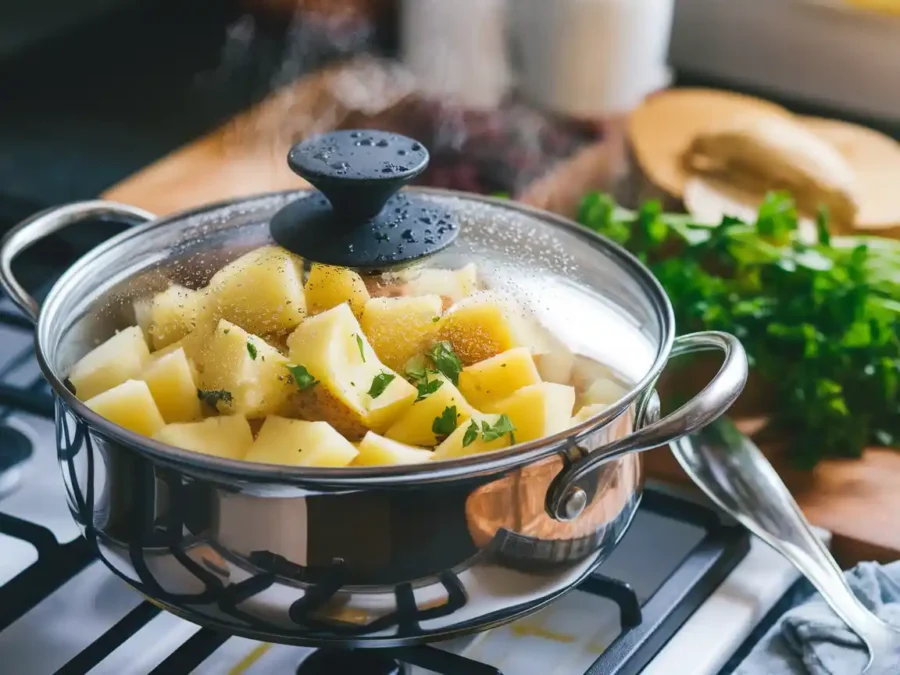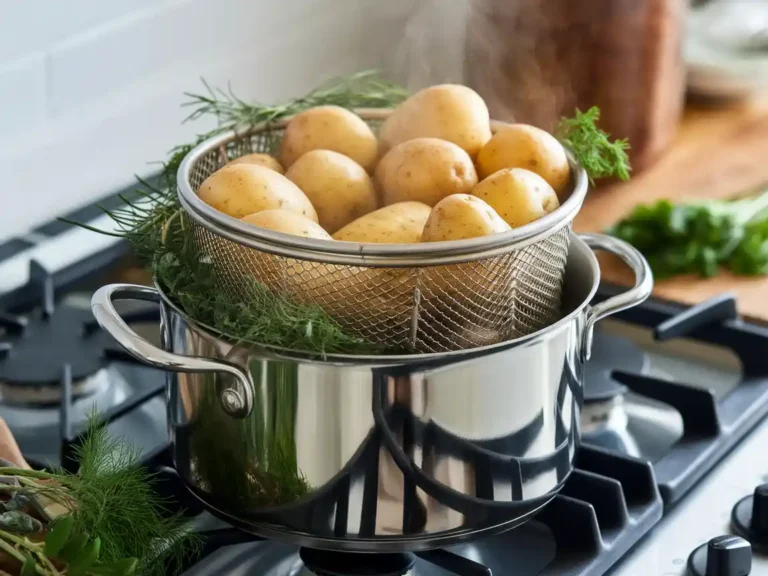When it comes to cooking potatoes, steaming often stands out as one of the healthiest and simplest methods. But let’s be honest getting the timing just right can feel like a mystery. If you’ve ever asked yourself, “How long does it take to steam a potato?” you’re not alone. The good news is, with the right information, you’ll never have to second-guess again. So, let’s dive deep into everything you need to know to master this cooking technique.
Table of Contents
Understanding the Basics of Steaming Potatoes
Steaming potatoes isn’t just about placing them in a pot and hoping for the best. It’s a delicate balance of timing, temperature, and preparation. Done right, it delivers tender, flavorful potatoes that are perfect for any dish.
Why Steaming Is the Best Cooking Method for Potatoes
Why is steaming potatoes such a big deal? For starters, steaming is gentler than boiling. Instead of submerging potatoes in water, which can leach out valuable nutrients, steaming uses hot vapor to cook them. This helps preserve their vitamins and minerals while also keeping their natural flavor intact.
“Steaming potatoes is like giving them a spa day it keeps them looking great and feeling even better!”
Plus, steaming is incredibly versatile. Whether you’re making a quick side dish or prepping potatoes for a more elaborate recipe, this method gives you a clean slate to build on.
Factors That Influence Steaming Time for Potatoes
Here’s where it gets interesting: not all potatoes steam at the same rate. A variety of factors can influence how long they’ll take to cook, including:
- Potato size: Whole potatoes take longer than smaller, diced pieces.
- Type of potato: Waxy varieties like red or fingerling potatoes cook faster than starchy ones like Russets.
- Altitude: At higher altitudes, water boils at a lower temperature, which can slightly extend cooking times.
- Equipment: The efficiency of your steamer setup matters. A tightly sealed pot or steamer basket speeds up the process.
The Science Behind Steaming Potatoes
Cooking isn’t just an art; it’s also a science. Understanding how steaming works can help you achieve consistently perfect results.
How Steam Cooks Potatoes: A Scientific Approach
When you steam potatoes, the water in your pot heats up and turns into vapor. This vapor surrounds the potatoes, transferring heat efficiently and evenly. Unlike dry heat methods like baking, steam doesn’t dry out the potatoes, so they stay moist and tender.
Nutritional Benefits of Steaming Potatoes
One of the best things about steaming is how it locks in nutrients. Potatoes are a great source of vitamin C, potassium, and fiber, but these can diminish with other cooking methods like boiling or frying. Steaming minimizes nutrient loss, making it one of the healthiest ways to prepare potatoes.
“Steamed potatoes are proof that healthy food can also taste amazing no compromises needed!”
Not to mention, steaming avoids the use of oils, keeping your meal lower in calories while still being satisfying.
Step-by-Step Guide to Steaming Potatoes
Now that you understand why steaming is so effective, let’s get into the step-by-step process. Trust me, it’s easier than you think, and you don’t need any fancy gadgets to get started.
Choosing the Right Potatoes for Steaming
Not all potatoes are created equal, and your choice will affect the outcome. Waxy potatoes like red, fingerling, or Yukon Gold are excellent for steaming because they hold their shape well and have a creamy texture. Starchy potatoes like Russets can also be steamed but may break apart if overcooked.
Preparing Potatoes Before Steaming
Before steaming, you’ll want to wash your potatoes thoroughly to remove any dirt. You can peel them if you prefer, but leaving the skin on adds texture and nutrients. If you’re working with larger potatoes, consider cutting them into smaller chunks for quicker cooking.
Time Estimates Based on Potato Size and Type
Timing is everything when it comes to steaming. Here’s a rough guide to get you started:
- Whole baby potatoes: 12–15 minutes
- Diced potatoes (1-inch pieces): 8–12 minutes
- Medium whole potatoes: 20–25 minutes
- Large whole potatoes: 30–35 minutes
To test if they’re done, pierce a potato with a fork. If it slides in easily without resistance, you’re good to go. Just be careful not to overcook them no one likes a mushy potato!
Troubleshooting: How to Avoid Common Steaming Mistakes
Even though steaming potatoes is straightforward, mistakes can still happen. Whether your potatoes are undercooked, overcooked, or just not turning out the way you hoped, don’t worry there are easy fixes for almost every issue.
What to Do If Potatoes Are Undercooked
There’s nothing worse than biting into a potato that’s still crunchy in the middle. If your potatoes are undercooked, simply return them to the steamer and let them cook for an additional 5–10 minutes. To avoid this problem in the future:
- Cut potatoes into evenly sized pieces for uniform cooking.
- Use a fork to check doneness before removing them from the steamer.
“When in doubt, cook it out! A few extra minutes in the steamer can save your potatoes and your meal.”
How to Prevent Overcooked or Mushy Potatoes
Overcooking is just as frustrating as undercooking. Mushy potatoes lose their structure and can feel unappetizing, especially if you’re planning to use them in salads or other dishes that require firm pieces. Here’s how to avoid this:
- Stick to recommended cooking times for the size and type of potato.
- Check for doneness early; it’s better to stop cooking too soon and add time later.
- Avoid overcrowding the steamer basket, which can lead to uneven cooking.
If you do end up with overcooked potatoes, don’t toss them! Use them in mashed potatoes, potato pancakes, or even soups where texture isn’t as critical.
Enhancing the Flavor of Steamed Potatoes
Steamed potatoes are delicious on their own, but they truly shine when paired with the right seasonings, herbs, and accompaniments. Think of them as a blank canvas waiting to be painted with flavor.
Herbs, Spices, and Additions for Better Flavor
Simple seasonings can transform steamed potatoes into something extraordinary. Here are a few ideas to get you started:
- Butter and garlic: Melted butter with minced garlic creates a rich, savory coating.
- Herbs: Fresh rosemary, thyme, dill, or parsley add brightness and depth.
- Spices: Smoked paprika, cumin, or chili powder bring warmth and complexity.
For a lighter option, toss your steamed potatoes with a drizzle of olive oil and a squeeze of lemon juice. The citrus adds a refreshing tang that balances the potatoes’ natural richness.
Pairing Steamed Potatoes with Other Dishes
Steamed potatoes are incredibly versatile and pair well with almost any main dish. Here are a few combinations to try:
- Roasted meats: Serve alongside roast chicken, beef, or pork for a classic comfort meal.
- Seafood: Pair with grilled salmon, shrimp, or white fish for a light, healthy dinner.
- Vegetarian options: Combine with sautéed vegetables and a creamy sauce for a filling, plant-based dish.
“Steamed potatoes play well with others they’re the perfect sidekick for any meal!”
Comparing Steaming Times for Different Cooking Methods

Steaming isn’t the only way to cook potatoes, but it does have some clear advantages. Let’s compare it to other common methods in terms of time, flavor, and texture.
Steaming vs. Boiling: Which Is Faster?
Boiling and steaming are similar in terms of cooking time, but steaming usually wins for two reasons:
- Faster heating: Steam surrounds the potatoes, cooking them evenly without needing to heat an entire pot of water.
- No draining: Once steaming is complete, there’s no need to dump out water or worry about waterlogged potatoes.
While boiling might be slightly quicker for large batches, steaming is a more efficient choice for smaller quantities or when preserving nutrients is a priority.
How Steaming Stacks Up Against Roasting or Baking
If you’re looking for crisp, golden edges, roasting or baking might be the way to go. However, these methods require higher cooking times up to 45 minutes or more making them less ideal for quick meals.
Steaming, on the other hand, is perfect for weeknight dinners or recipes where soft, tender potatoes are the goal. It’s also a great option when you’re avoiding added fats or oils.
Frequently Asked Questions About Steaming Potatoes
When it comes to steaming potatoes, a few common questions tend to pop up. Let’s tackle them one by one to ensure you’re fully equipped to master this cooking method.
Can You Steam Potatoes Without a Steamer?
Yes, absolutely! Even if you don’t own a steamer basket, you can easily improvise with items you already have in your kitchen. Here are two simple methods:
- Using a colander: Place the colander inside a pot, ensuring it doesn’t touch the water, then cover it with a lid.
- Using a plate and a trivet: Place a heatproof plate or bowl on a small trivet or overturned ramekin inside the pot. Add water to just below the plate level, and you’ve got a DIY steamer.
“Where there’s steam, there’s a way! You don’t need fancy tools to enjoy perfectly steamed potatoes.”
What’s the Fastest Way to Steam a Potato?
The fastest way to steam potatoes is to cut them into smaller, evenly sized pieces. Smaller pieces cook more quickly because steam can penetrate them more easily. Another time-saving tip is to use a microwave-safe steamer or a pressure cooker, both of which significantly reduce cooking time.
How Do You Know When Steamed Potatoes Are Done?
The easiest way to check if your potatoes are done is to pierce them with a fork or skewer. If it slides in easily without much resistance, the potatoes are ready. For a more precise method, use a kitchen thermometer potatoes are typically cooked through when they reach about 210°F (99°C) internally.
Can You Add Flavor During the Steaming Process?
Yes! Infusing flavor while steaming is simple. Add whole garlic cloves, rosemary sprigs, or slices of lemon to the water in the pot. The steam will carry these aromatic flavors into the potatoes, giving them a subtle but delightful taste.
Is Steaming Healthier Than Other Cooking Methods?
Yes, steaming is one of the healthiest ways to cook potatoes. Unlike frying or roasting, steaming requires no added fats and retains more of the potatoes’ natural nutrients. It’s an excellent choice if you’re looking to enjoy a clean, low-calorie dish.
Conclusion: Perfectly Steamed Potatoes Every Time
Steaming potatoes is a simple yet incredibly rewarding way to prepare this versatile ingredient. It combines the best of both worlds efficiency and nutrition making it an ideal method for busy weeknights or health-conscious cooking. Whether you’re steaming baby potatoes for a salad, preparing diced potatoes as a quick side dish, or using large whole potatoes as a base for a hearty meal, this technique delivers consistent, delicious results every time.
From understanding the science of steaming to experimenting with flavors and troubleshooting common issues, this guide has covered everything you need to know. Armed with this knowledge, you’re now ready to tackle any potato dish with confidence and creativity.
So, next time you’re staring at a bag of potatoes wondering what to do, remember: a steamer, a little patience, and some imagination are all you need to create something truly amazing. Happy cooking!

